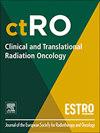Neoadjuvant prostate artery embolization prior to prostate radiation therapy: A single institution experience on the durability of clinical urinary improvement after radiation
IF 2.7
3区 医学
Q3 ONCOLOGY
引用次数: 0
Abstract
Background
Radiation therapy (RT) for prostate cancer has gastrointestinal and genitourinary toxicities, greater with baseline lower urinary tract symptoms (LUTS) and larger prostate volume (PV). Prostate artery embolization (PAE) improves LUTS and PV before RT. This study evaluates the durability of LUTS improvement from neoadjuvant PAE before prostate RT and oncologic outcomes.
Methods
We retrospectively identified patients receiving definitive prostate RT following PAE from a prospective database, including International Prostate Symptom Scores (IPSS), pre- and post-PAE MRI PV, and toxicity per CTCAEv5.0. Primary objective was LUTS by IPSS. Secondary objectives included biochemical recurrence-free survival (bRFS), local recurrence, and distant metastasis.
Results
From 9/2017–5/2024, 82 patients underwent PAE before RT, with 30.5 % having unfavorable intermediate risk. RT consisted of conventional fractionation (n = 21), moderate hypofractionation (n = 42), SBRT (n = 11), and EBRT/brachytherapy boost (n = 8); a subset of patients received androgen deprivation therapy. Pelvic lymph nodes were treated in 28 (34 %) patients. Median pre-PAE IPSS was 18 (range 2–34), PV 90 cc (14.2–240), and PSA 8.4 ng/mL (0.02–125.5). Post-PAE, mean IPSS reduction was 10.7 points (−13–30). Mean PV reduction was 30.9 cc (−9–136) or 32 %. PAE converted 52 % of patients contraindicated by size/IPSS for brachytherapy/SBRT. Post-RT, mean IPSS changes at 3, 6, 12, 18 and 24 months were −8.7, −8.5, −9.5, −8.9, and −7.6, respectively (p < 0.001). At 24.2-month median follow-up, 1 local recurrence occurred. Two-year bRFS was 92 % for non-metastatic patients.
Conclusion
Urinary improvement is durable after RT in men with large prostates and/or high LUTS burden with neoadjuvant PAE, and no increased risk of recurrence at intermediate-term follow-up. Further investigation is warranted.
前列腺放射治疗前的新辅助前列腺动脉栓塞:放射后临床尿改善持久性的单一机构经验
背景:前列腺癌放射治疗(RT)具有胃肠道和泌尿生殖系统毒性,基线下尿路症状(LUTS)和前列腺体积(PV)较大时毒性更大。前列腺动脉栓塞(PAE)可改善RT前的LUTS和PV。本研究评估前列腺RT前新辅助PAE改善LUTS的持久性和肿瘤预后。方法:我们回顾性地从前瞻性数据库中确定PAE后接受明确前列腺放疗的患者,包括国际前列腺症状评分(IPSS)、PAE前后MRI PV和CTCAEv5.0毒性。主要目的是通过IPSS进行LUTS。次要目标包括生化无复发生存(bRFS)、局部复发和远处转移。结果2017年9月至2024年5月,82例患者在放疗前接受了PAE,其中30.5%的患者存在不良中间风险。RT包括常规分割(n = 21)、中度低分割(n = 42)、SBRT (n = 11)和EBRT/近距离强化治疗(n = 8);一部分患者接受雄激素剥夺治疗。28例(34%)患者接受盆腔淋巴结治疗。pae前的中位IPSS为18(范围2-34),PV为90 cc (14.2-240), PSA为8.4 ng/mL(0.02-125.5)。pae后,IPSS平均降低10.7点(- 13-30)。平均PV减少30.9 cc(- 9-136)或32%。PAE将52%的有大小/IPSS禁忌的患者转为近距离治疗/SBRT。术后3、6、12、18和24个月的平均IPSS变化分别为- 8.7、- 8.5、- 9.5、- 8.9和- 7.6 (p < 0.001)。中位随访24.2个月时,局部复发1例。非转移性患者的2年bRFS为92%。结论大前列腺和/或高LUTS负担的新辅助PAE患者在接受RT治疗后尿路改善是持久的,中期随访时复发风险没有增加。有必要进一步调查。
本文章由计算机程序翻译,如有差异,请以英文原文为准。
求助全文
约1分钟内获得全文
求助全文
来源期刊

Clinical and Translational Radiation Oncology
Medicine-Radiology, Nuclear Medicine and Imaging
CiteScore
5.30
自引率
3.20%
发文量
114
审稿时长
40 days
 求助内容:
求助内容: 应助结果提醒方式:
应助结果提醒方式:


